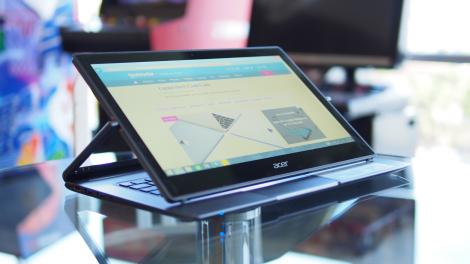
Introduction and design
Like other PC manufacturers, Acer has been experimenting with the convertible Ultrabook form factor. That journey started with last year’s Aspire R7, a multimodal laptop with an easel stand and a 15-inch display that makes it look and feel more like a transforming all-in-one desktop than a convertible notebook. This year’s Aspire R13 shows Acer has been listening to user feedback in slimming its multimodal design.
Starting at just $899 (£610, AU$1,170) with the latest Intel Broadwell processors and a 13-inch touchscreen display, the Acer Aspire R13 challenges convertibles including the Lenovo Yoga 3 Pro ($1,249, £850, AU$1,625), HP Spectre x360 ($1,149, £780, AU$1,495), and detachable 2-in-1s like the Surface Pro 3 ($799, £545, AU$1,040) and the Dell Venue 11 Pro 7000 series ($749, £510, AU$975).
These convertibles offer users the flexibility of using at least two different form factors – tablet or notebook – and the 360-degree swiveling hinges of the Spectre x360 and Yoga 3 Pro allow these hybrids to offer additional usage modes that compete with the swiveling screen on the Aspire R13.
However, given its Ultrabook heritage, the Acer Aspire R13 also competes in the traditional thin and powerful laptop category. Some strong competitors in this space include the 13-inch Apple MacBook Air, Dell XPS 13, and Asus Zenbook UX305.
Design
Like the more traditional Aspire S7, Acer uses a glass lid on the Aspire R13, giving it a more premium design. The glass lid design was originally pioneered by HP to give a nice sheen to premium Ultrabooks and an alternative to aluminum-clad offerings. Like the Envy 14 Spectre from early 2012, the drawback is that the black glass top is a fingerprint magnet on the Aspire R13 and could make the laptop more fragile than an aluminum or plastic lid design.
With the lid closed, the Aspire R13 looks unfinished with missing parts. That’s because the frame that houses the swiveling screen only covers the bottom half of the screen, leaving the top part open, unlike the full frame used on Dell’s XPS 12’s swiveling screen.
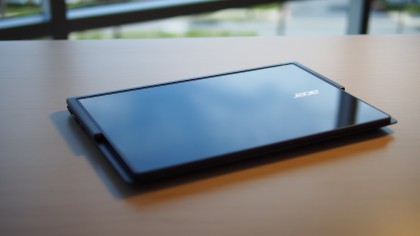
It’s this unique hinged screen design that gives the Aspire R13 a larger footprint than traditional 13-inch laptops. For comparison, measuring 13.54 x 9.07 x 0.71 inches (34.39 x 23.04 x 1.80cm), the Aspire R13 is wider and longer, but slimmer, than the 14-inch Lenovo ThinkPad T450s, which comes in at 13.03 x 8.90 x 0.83 inches (33.10 x 22.61 x 2.11cm). Even though the Aspire R13 is the same thickness as the 13-inch MacBook Pro with Retina display, it takes up more desk space than the 12.35 x 8.62-inch (31.37 x 21.89cm) base dimensions of Apple’s laptop.
Coming in at 3.31 pounds (1.50kg), the Aspire R13’s weight is heavier than some consumer Ultrabooks. Apple’s MacBook Air with a similar screen size weighs only 2.97 pounds (1.35kg) while the MacBook Pro with Retina display comes in at 3.48 pounds (1.58kg), but has a more solid unibody aluminum construction. Dell’s sleek XPS 13 is 2.8 pounds (1.27kg) with a touchscreen.

Another downside to the unique Ezel hinge is that the lid is difficult to open because there isn’t much surface to grip with the open top design. Once the lid is open, you’ll find the screen can be positioned in up to six different modes – two more modes than on the Lenovo Yoga 3 Pro.
You can use the Aspire R13 in Notebook, Ezel, Stand, Pad (tablet), Tent, or Display modes. Despite the number of multi-modes for the screen, it’s doubtful that users will regularly use all the modes available. For example, unless I am using the optional stylus, Ezel mode is very similar to notebook mode, and I found myself mainly using the traditional notebook form factor after the novelty of the swiveling display ran out.
All the usage modes highlight the bright IPS display, which presents images with good saturation, vivid colors, and wide viewing angles.
For those who prefer typing, the Notebook mode will offer a traditional Ultrabook experience. The matte, dark grey plastic keyboard deck houses full-sized chicklet keys.
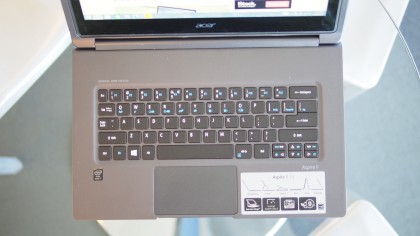
I found that the keyboard backlight emits an odd aqua-green hue, and it isn’t bright so you’ll likely find it useful only in the darkest of workspaces. Additionally, key travel is shallow, so typing doesn’t feel too comfortable, despite the keys being responsive and springy.
Given the large footprint of the Aspire R13 compared to Ultrabooks with a similar display size, Acer hasn’t made the most of the space available. There isn’t a dedicated row of function keys, which isn’t too big of a deal. The problem is that Acer moved a few of the lesser used symbol keys around on the keyboard, leading to extremely shrunken Caps Lock and Esc keys.
Although the keyboard could be improved to offer more key travel, I found the wide, clickable trackpad comfortable to use. The trackpad is sensitive and accurate, offering great cursor tracking precision.
The left side of the Aspire R13 houses two USB ports along with a full-size HDMI port, while the right side houses the memory card slot and a third USB port.
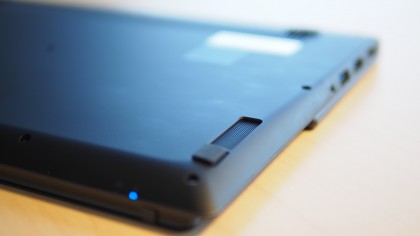
The Aspire R13 has stereo bottom-firing speakers on the undercarriage, which itself is made up of soft-touch plastic. Advertised with what Acer dubs as “cinematic surround sound,” the built-in Dolby Digital Plus Home Theater speakers are crisp, even at high volumes, but lack bass, an understandable compromise given the slim body of the notebook.
Specifications and usage modes
If you’re looking for a stylish Ultrabook that will grow with you, the base $899 (£610, AU$1,170) configuration for the Aspire R13 probably represents the best value. At that price, the Aspire R13 will compete with notebooks with a traditional clamshell form factor, like the $1,299 (£885, AU$1,690) configuration of the Dell XPS 13 with its bezel-less infinity display, $1,149 (£780, AU$1,495) Lenovo Yoga 3 Pro, and the $999 (£680, AU$1,300) Apple MacBook Air with a 13-inch display.
The main difference between the Aspire R13 and more traditional notebooks is that it can readily convert into a tablet – among other form factors – so you don’t need to travel with both a laptop and a tablet.
Here’s how the unit sent to TechRadar for review was configured:
Spec sheet
- Processor: 2.4GHz dual-core Intel Core i7-5500U
- Graphics: Intel HD 5000 with shared memory
- Memory: 8GB RAM (DDR3L, 1,600Mhz)
- Storage: 256GB SSD
- Screen: 13.3-inch WQHD, 2,560 x 1,440 touchscreen
- Camera: 720p webcam
- Wireless: Bluetooth 4.0; 802.11ac (B/G/N), dual-band Wi-Fi
- Ports: HDMI, 2x USB 3.0 (one always-on charging port), 1x USB 2.0, memory card reader, 3.5mm combo jack
- Battery: Four-cell
- OS: Windows 8.1
As configured, our review unit has a suggested retail price of $1,299 (£885, AU$1,690). Upgrading the solid state drive to a 512GB capacity will give you the priciest configuration for the Aspire R13 series, bringing the cost to $1,499 (£1,020, AU$1,950). The entry-level configuration ships with a dual-core Broadwell Core i5 processor with integrated Intel HD 5500 graphics, 8GB RAM, 128GB SSD, and a 13.3-inch full HD resolution touchscreen.
Usage modes
With six usage modes, the Aspire R13 also improves on the design of the Aspire R7. Rather than having the touchpad above the keyboard deck, the Aspire R13 reverts to a more traditional design with the trackpad below the keyboard deck. Not only is this more familiar, but with the screen tilted and angled in “Ezel,” or easel, mode, the display no longer covers the touchpad.
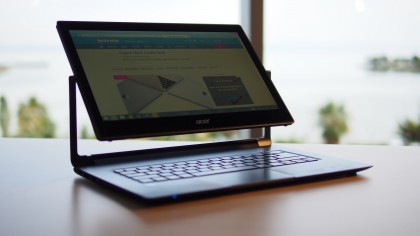
In the more traditional notebook mode, I found that the Aspire R13 is comfortable to use, despite its larger footprint than a traditional notebook with the same screen size. The WQHD resolution display is a joy to use.
In notebook mode, just tilting the screen using the side hinges will engage the Ezel mode. The result is similar to an artist’s ease. This mode still provides access to the keyboard and touchpad, but brings the screen closer to the user.
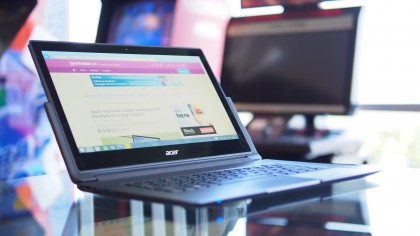
Stand mode is similar to Ezel mode, but gives the screen a lower profile. This mode is similar to opening the kickstand to its wider settings on the Surface Pro 3, and provides for an angled canvas, similar to what digital artists have with a Wacom Cintiq tablet. When used with the optional Active Stylus, stand mode provides for a comfortable position to sketch and draw.
I prefer the hinge mechanism on the Surface Pro 3 over the Ezel hinge on the Aspire R13 when using either the Ezel mode or stand mode. The Surface Pro 3 has a stiffer hinge that makes it harder to accidentally tilt the screen when pressure is applied, a trait that’s useful when resting my hand or palm on the screen when using a digital stylus for inking or drawing.

Pad mode converts the notebook into a tablet. Given the heavier 3.31-pound weight of the Aspire R13 over the 1.75-pound (0.79kg) Surface Pro 3 without the keyboard or a 0.96-pound (0.44kg) iPad Air 2, I found myself not using pad mode all too often.
In the kitchen, when cooking, I prefer using the Epicurious Windows app and tent mode. This mode keeps the keyboard away from the hazards of the kitchen – like splashes of water, liquids and flour.
The last mode, display mode, will probably be used most by students and business professionals. For students, it brings the screen forward and hides the keyboard, giving a clear view for movies, photos, and media. For business users, the mode is great for small, casual presentations.
Performance and benchmarks
Equipped with Intel’s latest Broadwell processors and integrated graphics, the performance of the Aspire R13 is consistent with the Ultrabook category, posting similar results to the Dell XPS 13 and the Zenbook UX305.
Benchmarks
- PCMark 8: Home: 2,258; Work: 2,190
- PCMark 8 Battery Life: 3 hour and fifteen minutes (50% screen brightness)
- 3DMark: Fire Strike: 656; Cloud Gate: 3,716; Sky Diver: 2,248
- Cinebench: GPU: 26.22 fps; CPU: 207
Performance
Although within range, the results show that in many of the categories, the Aspire R13 fared slightly worse than the Ultrabook average. The higher WQHD resolution display, compared to a standard full HD display on standard Ultrabook, may be a culprit of the slightly degraded performance numbers.
Despite having a weaker Intel Core i5 processor and the same Intel HD 5500 integrated graphics, the Dell XPS 13 with QHD+ display fared better than the Aspire 13 in graphics tests.
Dell’s XPS 13 posted better performance in all three 3DMark benchmarks than the Aspire R13, scoring 4,935, 2,745 and 739 for the Cloud Gate, Sky Diver and Fire Strike tests respectively. The Aspire R13 performed better in the PCMark Home test, posting a score of 2,258, compared to the 2,104 on the XPS 13. Processor performance using the Cinebench tool is also higher on the XPS 13, with a score of 258 compared to the 207 on the Aspire R13.
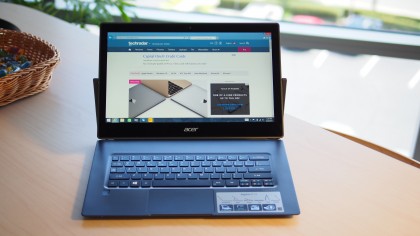
Similarly, despite an even weaker Intel Core M processor on our Asus Zenbook UX305 review and lesser HD 5300 graphics, the performance difference compared to the Aspire R13 is negligible. It’s unclear why the Aspire R13 didn’t post stronger numbers given its Broadwell Core i7 processor.
The Zenbook UX305 posted similar CPU scores to the Aspire R13 with the Cinebench test, but the GPU performance is weaker with a score of 21.28 fps compared to the 26.22 fps on the Aspire R13.
In my real-world usage, despite degraded numbers, the Aspire R13 had no issues opening multiple apps, running multiple Chrome tabs, working with Adobe Photoshop and basic video editing with Adobe Premiere.
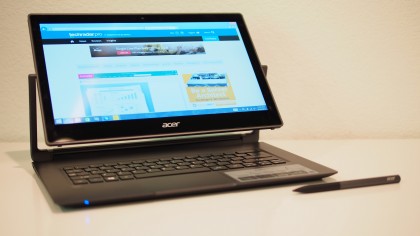
The problem I had with the Aspire R13 is that the Ultrabook runs warmer than competitors like the MacBook Air and the ThinkPad T450s. With heat output being high, though not overly hot that the Aspire R13 couldn’t be used on a lap, the fan would kick in, and fan noise became an issue.
Another issue with noise is that unless the Aspire R13 is fully shut down, I found that my review unit emitted a high pitch buzz when it is put to sleep. Unless you have sensitive ears, most users likely wouldn’t notice this high pitch buzz.
Battery life is commendable, but not great. The Aspire R13 managed just under seven hours of continuous usage with screen brightness set to 50% performing various tasks as occasional photo cropping in Photoshop, streaming YouTube videos, browsing the internet on multiple Chrome windows and running the Pidgin messaging client in the background.
Digital inking
Unlike the Surface Pro 3, digital inking is more of a bonus afterthought on the Aspire R13. The Acer Active Stylus is an optional $50 (£35, AU$65) accessory, and one that is usable, but lacks the sensitivity and precision of the Surface Pen.
Despite Acer’s claim of 255 levels of pressure sensitivity, I found that pressure sensitivity is not as precise as the pens for the Surface Pro 2 or Surface Pro 3, when used for drawing and painting. Additionally, palm rejection is a mixed bag on the Aspire R13. For taking notes, I found that the unit would sometimes not recognize and reject my palm when I am using the pen, resulting in my hand registering errant inputs on the screen.
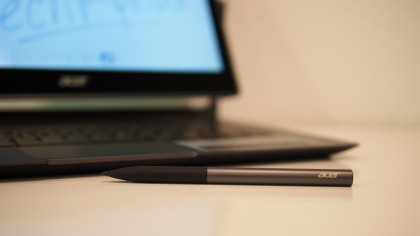
The pen seems more suited for casual use than for creative professionals and digital artists. It’s fine to mark up a PDF for edits and comments, sign digital documents, or the occasional sketches, but creative professionals likely may want to look at other options for more precise work.
Verdict
As an Ultrabook, Acer has delivered a solid, if not slightly larger, offering in the Aspire R13. Acer’s transforming convertible is more affordably priced than many traditional Ultrabooks, yet delivers more form factors and usage modes for consumers to interact with, consume, and create content. Solid, if not average, specs and performance make this a great choice for those needing a touchscreen convertible.
We liked
The converting Ezel hinge makes for a versatile computing experience with six usage modes, highlighting a great IPS display. At its base configuration, this device offers a great value for its performance.
Solid build quality and a unique design also give the Aspire R13 plenty of desk appeal, but at this time it’s unclear how well the glass lid will hold up over time.
We disliked
Given that most people wouldn’t use all of the modes enabled by the Ezel hinge, it can sometimes feel like you’re paying for unnecessary features. In my review of the Aspire R13, I find myself using only a few modes – tent mode in bed watching videos, display mode on my desk showcasing pictures and previewing presentations, notebook mode in my lap for a more traditional computing experience, and pad mode when reviewing documents for edits.
In fact, these commonly used modes are already found on Acer’s competitors, like the Lenovo Yoga Pro 3 and the HP Spectre x360, making Ezel and stand mode seem like superfluous additions on the Aspire R13.
The major pitfall with the Aspire R13 is that despite its weaker benchmarked performance compared to systems with similar specifications, the unit runs warm and the fan is almost constantly on, leading to a rather distracting computing experience if you’re hoping to use the Aspire R13 in a library or quiet room.
Final verdict
It’s hard not to like Acer’s interpretation of convertible notebooks. The Aspire R13 packs in a whopping six usage modes with a unique Ezel hinge, a design that as an Ultrabook makes the Aspire R13 feel unfinished with a partial frame. Even though real-world performance is on par with most Ultrabooks, the Aspire R13’s benchmark scores were considerably lower than the business-class Lenovo ThinkPad T450s with a lesser processor.
While the base configuration delivers great price to performance value, what makes the Aspire R13 unique is its multimodal design. With more expensive configurations of the Aspire R13 – unless you need the multimodal computing experience Acer is selling – you may find better value in a fully configured Dell XPS 13 or Surface Pro 3, the former offering a more compact frame while the latter delivers a lighter body for use as a tablet with an optional keyboard to transform it into an Ultrabook.
![]()
Related Posts
December 6, 2021
7+ Web Design Trends for 2022: Which Will You Use?
December 6, 2021
The 10 Best WordPress Booking Plugins to Use On Your Website
December 6, 2021
How to Use a Web Cache Viewer to View a Cached Page
November 6, 2021
10 Modern Web Design Trends for 2022
November 6, 2021
Best Free SSL Certificate Providers (+ How to Get Started)
November 6, 2021
How to Design a Landing Page That Sends Conversions Skyrocketing
November 6, 2021
What Are the Best WordPress Security Plugins for your Website?
October 6, 2021
Your Guide to How to Buy a Domain Name
October 6, 2021
How to Build a WordPress Website: 9 Steps to Build Your Site
September 6, 2021
10 Best Websites for Downloading Free PSD Files
September 6, 2021
HTML5 Template: A Basic Code Template to Start Your Next Project
September 6, 2021
How Much Does It Cost to Build a Website for a Small Business?
September 6, 2021
A List of Free Public CDNs for Web Developers
September 6, 2021
6 Advanced JavaScript Concepts You Should Know
August 6, 2021
10 Simple Tips for Launching a Website
August 6, 2021
25 Beautiful Examples of “Coming Soon” Pages
August 6, 2021
10 Useful Responsive Design Testing Tools
August 6, 2021
Best-Converting Shopify Themes: 4 Best Shopify Themes
July 6, 2021
What Is Alt Text and Why Should You Use It?
July 6, 2021
24 Must-Know Graphic Design Terms
June 6, 2021
How to Design a Product Page: 6 Pro Design Tips
April 6, 2021
A Beginner’s Guide to Competitor Website Analysis
April 6, 2021
6 BigCommerce Design Tips For Big Ecommerce Results
April 6, 2021
Is WordPress Good for Ecommerce? [Pros and Cons]
March 6, 2021
Make Websites Mobile-Friendly: 5 Astounding Tips
March 6, 2021
Shopify vs. Magento: Which Platform Should I Use?
March 6, 2021
Top 5 Web Design Tools & Software Applications
February 6, 2021
Website Optimization Checklist: Your Go-To Guide to SEO
February 6, 2021
5 UX Design Trends to Dazzle Users in 2021
February 6, 2021
What Is the Average Page Load Time and How Can You Do Better?
February 6, 2021
Choosing an Ecommerce Platform That Will Wow Customers
February 6, 2021
7 Best Practices for Crafting Landing Pages with Forms
February 6, 2021
7 B2B Web Design Tips to Craft an Eye-Catching Website
January 6, 2021
Mobile-Friendly Checker | Check Your Site’s Mobile Score Now
January 6, 2021
8 Tips for Developing a Fantastic Mobile-Friendly Website
December 6, 2020
How to Add an Online Store to Your Website [4 Ways]
December 6, 2020
5 UX Design Tips for Seamless Online Shopping
November 6, 2020
Ecommerce Website Essentials: Does Your Site Have All 11?
November 6, 2020
5 Small Business Website Essentials You Need for Your Site
November 6, 2020
Your Website Redesign Checklist for 2020: 7 Steps for Success
May 1, 2020
Psychology of Color [Infographic]
April 21, 2020
How to start an online store that drives huge sales
January 3, 2020
5 Lead Generation Website Design Best Practices
March 6, 2019
6 Reasons You Should Redesign Your Website in 2019
March 6, 2019
7 Web Design Trends for 2019
February 19, 2019
Who owns the website/app source code, client or developer
February 7, 2019
Don’t Let Your Domain Names Expire in 2019
January 8, 2019
2019 Website Development Trends To Note
October 6, 2017
How Web Design Impacts Content Marketing
October 6, 2017
How to Choose a Navigation Setup
August 6, 2017
Why User Experience Matters to Marketing
July 6, 2017
5 Ways Web Design Impacts Customer Experience
September 6, 2016
How to Learn Angular
September 6, 2016
The Excuses for Not Having a Website (Infographic)
September 6, 2016
How to Build an Award-Winning Web Design Team
September 6, 2016
13 Free Data Visualization Tools
August 6, 2016
How Selling Pastries Helped Us Design a Better Product
August 6, 2016
11 Sites to Help You Find Material Design Inspiration
July 4, 2016
How to change free wordpress.com url
April 6, 2016
The 5 Best Free FTP Clients
April 6, 2016
7 Free UX E-Books Worth Reading
March 6, 2016
Can Handwritten Letters Get You More Clients?
December 10, 2015
Star Wars Week: How to create your own Star Wars effects for free
December 6, 2015
20 "Coming Soon" Pages for Inspiration
December 6, 2015
6 Free Tools for Creating Your Own Icon Font
December 6, 2015
9 Useful Tools for Creating Material Design Color Palettes
November 6, 2015
20 Free UI Kits to Download
November 6, 2015
50 Web Designs with Awesome Typography
November 6, 2015
When to Use rel="nofollow"
November 6, 2015
7 Free Books That Will Help You Become More Productive
November 6, 2015
50 Beautiful One-Page Websites for Inspiration
November 6, 2015
Circular Images with CSS
October 6, 2015
Lessons Learned from an Unsuccessful Kickstarter
October 6, 2015
5 Games That Teach You How to Code
October 6, 2015
Cheatsheet: Photoshop Keyboard Shortcuts
October 6, 2015
An Easy Way to Create a Freelance Contract for Your Projects
October 6, 2015
50 Design Agency Websites for Inspiration
September 29, 2015
JB Hi-Fi shutting the book on ebooks
September 24, 2015
Opinion: Quick, Quickflix: It's time to give yourself the flick
September 24, 2015
New Star Wars 360-degree video is among first on Facebook
September 21, 2015
Apple purges malicious iPhone and iPad apps from App Store
September 12, 2015
Apple's new Live Photos feature will eat up your storage
September 12, 2015
The latest Windows 10 Mobile preview has been delayed
September 12, 2015
IBM buys StrongLoop to add Node.js development to its cloud
September 8, 2015
Fake Android porn app takes your photo, then holds it ransom
September 6, 2015
50 Restaurant Websites for Inspiration
September 6, 2015
Zero UI — The Future of Interfaces
September 6, 2015
50 Beautiful Websites with Big Background Images
September 6, 2015
Infographic: 69 Web Design Tips
September 6, 2015
Free Windows 10 Icons
September 2, 2015
Instagram turns itself into a genuine messaging service
August 11, 2015
In Depth: How Microsoft taught Cortana to be more human
August 11, 2015
Windows 10 price, news and features
August 11, 2015
Windows 10's broken update introduces endless reboot loop
August 11, 2015
Windows 10 races to 27m installs
August 11, 2015
Windows 10 IoT Core gets first public release
August 10, 2015
iOS Tips: How to backup iPhone to an external drive
August 10, 2015
Windows 8.1 RT finally getting Windows 10 Start Menu
August 10, 2015
How to use Windows Hello
August 10, 2015
Review: Moto Surround
August 10, 2015
Review: Moto G (2015)
August 9, 2015
8 of the best free VPN services
August 8, 2015
Use Firefox? Mozilla urges you update ASAP
August 7, 2015
Mac Tips: Apple Mail: How to remove the Favorites Bar
August 7, 2015
How to make the OS X dock appear faster
August 7, 2015
Review: BQ Aquaris E45 Ubuntu Edition
August 7, 2015
Review: Acer Liquid Jade Z
August 6, 2015
How to reinstall Linux
August 6, 2015
How to reinstall Windows
August 6, 2015
Updated: Apple Music: release date, price and features
August 6, 2015
Social News Websites for Front-End Developers
August 6, 2015
10 Free JavaScript Books
August 6, 2015
50 Beautiful Blog Designs
August 6, 2015
Animated SVG Pipes Effect
August 6, 2015
Launching Your First App
August 5, 2015
Windows 10 goes freemium with paid apps
August 5, 2015
Updated: Week 1 with Windows 10
August 5, 2015
Mac Tips: How to manage Safari notifications on Mac
August 5, 2015
Microsoft Sway may kill the PowerPoint presentation
August 4, 2015
Microsoft gives Outlook on the web a new look
August 4, 2015
Mac OS X vulnerable to new zero-day attack
August 4, 2015
Windows 10 users warned of two scams
August 4, 2015
Microsoft's Docs.com is now available to everyone
August 3, 2015
Mac Tips: How to edit the Favorites sidebar on Mac
August 3, 2015
Updated: Windows 10 price, news and features
July 29, 2015
Review: HP ProDesk 405 G2
July 29, 2015
Hands-on review: HP Elite x2 1011
July 29, 2015
Hands-on review: Updated: Windows 10 Mobile
July 29, 2015
Review: Updated: Nvidia Shield Android TV
July 28, 2015
LIVE: Windows 10 launch: Live Blog!
July 28, 2015
How to prepare for your upgrade to Windows 10
July 28, 2015
Review: Updated: Windows 10
July 28, 2015
Review: Updated: HP Pro Tablet 608
July 28, 2015
Review: Heat Genius
July 28, 2015
Hands-on review: Moto X Play
July 28, 2015
Hands-on review: Moto X Style
July 28, 2015
Hands-on review: Moto G (2015)
July 28, 2015
Review: 13-inch MacBook Air (early 2015)
July 28, 2015
Hands-on review: OnePlus 2
July 28, 2015
Review: LG 65EG960T 4K OLED
July 28, 2015
Mac Tips: How to share printers on Mac
July 27, 2015
Apple Music's arrival hasn't opened Pandora's box
July 26, 2015
Review: Garmin Swim
July 25, 2015
How to merge OS X contacts into an existing list
July 25, 2015
Hands-on review: UPDATED: ZTE Axon
July 24, 2015
Mac Tips: How to zoom in on a Mac
July 24, 2015
What Windows 10 means for the enterprise
July 24, 2015
Review: JBL Charge 2 Plus
July 24, 2015
Review: Acer Aspire S7
July 24, 2015
Review: Updated: Canon G3 X
July 24, 2015
Review: Updated: iPad Air 2
July 24, 2015
Review: Thinksound On1
July 24, 2015
Review: Asus Chromebook Flip
July 24, 2015
Review: Garmin Forerunner 225
July 23, 2015
Review: Garmin nuvi 68LM
July 23, 2015
Review: Samsung Galaxy S6 Active
July 23, 2015
Review: Bowers and Wilkins P5 Wireless
July 23, 2015
Review: Dell XPS 15 (2015)
July 21, 2015
Review: Fuji S9900W
July 21, 2015
Review: Updated: Fitbit Surge
July 21, 2015
Review: UE Roll
July 21, 2015
Hands-on review: Ubik Uno
July 20, 2015
Review: Samsung HW-J650
July 20, 2015
Updated: 40 best Android Wear smartwatch apps 2015
July 20, 2015
Review: Acer Chromebook C740 review
July 20, 2015
Review: Huawei Talkband B2
July 20, 2015
Review: Dell Venue 10 7000
July 20, 2015
Review: Intel Core i7-5775C
July 17, 2015
Mac Tips: How to delete locked files on Mac
July 17, 2015
Review: Pebble Time
July 16, 2015
Microsoft just made Windows XP even less secure
July 16, 2015
Windows 8.1 RT is getting an update this September
July 16, 2015
OS showdown: Windows 10 vs Windows 8.1 vs Windows 7
July 16, 2015
Review: Acer CB280HK
July 15, 2015
Windows 10 is ready for new laptops and PCs
July 15, 2015
Explained: How to take a screenshot in Windows
July 15, 2015
Office for Windows 10 appears in latest build
July 14, 2015
Review: ZTE Axon
July 14, 2015
Review: ViewSonic VP2780-4K
July 14, 2015
Hands-on review: SanDisk Connect Wireless Stick
July 14, 2015
Review: Oppo PM-3
July 14, 2015
Review: BT 11ac Dual-Band Wi-Fi Extender 1200
July 14, 2015
Review: Fuji X-T10
July 13, 2015
How to build an SEO strategy for your business
July 13, 2015
Review: Lenovo ThinkPad Yoga 15
July 13, 2015
Review: Audio-Technica ATH-MSR7
July 13, 2015
Review: Garmin NuviCam LMT-D
July 13, 2015
Review: Dell Inspiron 13 7000
July 13, 2015
Hands-on review: AstroPi SenseHAT
July 13, 2015
Hands-on review: EE Rook
July 13, 2015
Hands-on review: Updated: HTC Vive
July 12, 2015
Here's the ultimate software list for PC fanatics
July 10, 2015
How to use the new Photos app for Mac
July 10, 2015
Windows 10 Insider Preview Build 10166 available now
July 10, 2015
Splunk spends big on cybersecurity acquisition
July 10, 2015
Making Windows 10 apps just got a whole lot easier
July 10, 2015
Review: Lenovo LaVie Z 360
July 9, 2015
OS X El Capitan public beta available right now
July 9, 2015
Microsoft finally unveils Office 2016 for Mac
July 9, 2015
Review: Updated: Chromecast
July 9, 2015
Review: Updated: Tesco Hudl 2
July 9, 2015
Review: Lenovo ThinkPad E550
July 9, 2015
Review: Updated: Google Nexus 6
July 8, 2015
What you need to know about Windows Server 2016
July 7, 2015
Microsoft to hike enterprise cloud pricing
July 6, 2015
Hacking Team end up being totally 0wned
July 6, 2015
Review: HP Pro Slate 12
July 6, 2015
Review: Samsung 850 Pro 2TB
July 6, 2015
Review: Asus RT-AC87U
July 6, 2015
Review: Jawbone UP2
July 6, 2015
Reimagining the Web Design Process
July 6, 2015
50 Clean Websites for Inspiration
July 6, 2015
15 Free Books for People Who Code
July 6, 2015
Web Storage: A Primer
July 6, 2015
A Look at Some CSS Methodologies
July 3, 2015
6 Essential Mac Mouse and Trackpad Tips
July 2, 2015
How to install a third party keyboard on Android
July 2, 2015
Review: UPDATED: Asus Zenfone 2
July 2, 2015
Review: Alienware 13
July 2, 2015
Review: HP DeskJet 1010
July 1, 2015
5 issues we want Apple Music to fix
June 13, 2015
Cortana will get its own button on Windows 10 PCs
June 12, 2015
Windows 10 will come with universal Skype app
June 12, 2015
iPad music production: 18 Best apps and gear
June 12, 2015
Windows 10 all set for early enterprise struggle
June 12, 2015
Review: Garmin VIRB Elite
June 11, 2015
Review: Updated: Nvidia Shield Tablet
June 11, 2015
Review: Nokia Lumia 635
June 10, 2015
Microsoft brings more online tweaks to Office 365
June 10, 2015
Mac Tips: How to use Screen Sharing in Mac OS X
June 9, 2015
Hands-on review: Meizu M2 Note
June 9, 2015
Hands-on review: EE 4GEE Action Camera
June 9, 2015
Review: Toshiba 3TB Canvio external hard drive
June 9, 2015
Review: Olympus SH-2
June 8, 2015
Hands-on review: Updated: Apple CarPlay
June 8, 2015
UPDATED: iOS 9 release date, features and news
June 8, 2015
Review: Updated: Roku 2
June 8, 2015
Review: Updated: PlayStation Vue
June 8, 2015
Review: Dell PowerEdge R730
June 8, 2015
Review: Canon SX710 HS
June 7, 2015
UPDATED: iOS 9 release date, features and rumors
June 7, 2015
Review: Lenovo S20-30
June 6, 2015
Free Writing Icons
June 6, 2015
15 CSS Questions to Test Your Knowledge
June 6, 2015
The Best CSS Reset Stylesheets
June 6, 2015
How CSS Specificity Works
June 5, 2015
'Delay' is a new feature in Windows 10
June 5, 2015
Review: Beyerdynamic Custom One Pro Plus
June 5, 2015
Latest SEO Marketing tools
June 5, 2015
Review: Nvidia Shield Android TV
June 5, 2015
Review: Honor 4X
June 5, 2015
Review: In Depth: Oppo R5
June 3, 2015
Hands-on review: Huawei P8 Lite
June 3, 2015
How To: How to create eBooks on a Mac
June 3, 2015
Review: Updated: Tidal
June 3, 2015
Review: Canon 750D (Rebel T6i)
June 2, 2015
Review: Updated: Asus ZenWatch
June 2, 2015
Review: Alcatel OneTouch Idol 3
June 2, 2015
Review: Updated: Nokia Lumia 1520
June 2, 2015
Review: Updated: Yotaphone 2
June 2, 2015
Review: Updated: Nokia Lumia 625
June 2, 2015
Review: Creative Muvo Mini
June 1, 2015
Review: Acer TravelMate P645 (2015)
June 1, 2015
Hands-on review: Corsair Bulldog
May 29, 2015
In Depth: NetApp: a requiem
May 29, 2015
July is looking definite for Windows 10 release
May 29, 2015
Hands-on review: Google Photos
May 28, 2015
Mac Tips: The 16 best free GarageBand plugins
May 28, 2015
Review: Canon 760D (Rebel T6s)
May 27, 2015
Review: Lenovo Yoga 3 14
May 27, 2015
Hands-on review: Serif Affinity Photo
May 27, 2015
Review: Garmin Vivoactive
May 26, 2015
Review: Datacolor Spyder5 Elite
May 26, 2015
Hands-on review: Sony Xperia Z3+
May 26, 2015
Review: Epson BrightLink Pro 1410Wi
May 26, 2015
Review: Technics Premium C700
May 26, 2015
Review: Canon EOS M3
May 26, 2015
Review: Updated: HTC One M9
May 26, 2015
Review: Updated: Sony Xperia Z3 Compact
May 25, 2015
Review: Updated: New Nintendo 3DS
May 25, 2015
Updated: 50 best Mac tips, tricks and timesavers
May 25, 2015
Updated: Windows email: 5 best free clients
May 25, 2015
Instagram is planning to invade your inbox
May 25, 2015
Review: Updated: Foxtel Play
May 24, 2015
How Windows 10 will change smartphones forever
May 24, 2015
Review: Vodafone Smart Prime 6
May 24, 2015
Review: Updated: iPad mini
May 22, 2015
Office Now may be Cortana for your work life
May 22, 2015
Review: Updated: Lenovo Yoga 3 Pro
May 22, 2015
Review: Microsoft Lumia 640 LTE
May 22, 2015
Review: Updated: Fitbit Flex
May 21, 2015
Updated: Best free Android apps 2015
May 21, 2015
Review: Asus ZenBook Pro UX501
May 21, 2015
Review: Sennheiser Momentum In-Ear
May 20, 2015
Hands-on review: UPDATED: Asus Zenfone 2
May 20, 2015
OS X 10.11 release date, features and rumors
May 18, 2015
Updated: Best free antivirus software 2015
May 18, 2015
iPhone 6S rumored to launch as soon as August
May 18, 2015
Microsoft ready to pounce and acquire IFS?
May 17, 2015
5 of the most popular Linux gaming distros
May 16, 2015
Review: Acer Chromebook 15 C910
May 16, 2015
Review: Lenovo ThinkPad X1 Carbon (2015)
May 16, 2015
Review: Polk Nue Voe
May 16, 2015
The top 10 data breaches of the past 12 months
May 16, 2015
Hands-on review: Updated: LG G4
May 16, 2015
Review: Updated: Quickflix
May 16, 2015
Review: LG Watch Urbane
May 16, 2015
Review: Razer Nabu X
May 16, 2015
Hands-on review: Updated: Windows 10
May 16, 2015
Review: UPDATED: Moto X
May 16, 2015
Review: Updated: Moto G (2013)
May 12, 2015
Review: TomTom Go 50
May 12, 2015
Review: Updated: Moto G (2014)
May 12, 2015
Review: Garmin Vivofit 2
May 12, 2015
Review: Asus Transformer Book Flip TP300LA
May 11, 2015
Review: MSI GT80 Titan
May 11, 2015
Review: Monster SuperStar BackFloat
May 9, 2015
Review: Updated: Apple Watch
May 7, 2015
5 million internet users infected by adware
May 7, 2015
Review: Updated: New MacBook 2015
May 6, 2015
Android M will be shown at Google IO 2015
May 6, 2015
Review: Epson WorkForce Pro WF-4630
May 6, 2015
Review: Master & Dynamic MH40
May 6, 2015
How to Use Gulp
May 6, 2015
Getting Started with Command-Line Interfaces
May 6, 2015
What It’s Like to Contribute to WordPress
May 6, 2015
Ultimate Guide to Link Types for Hyperlinks
May 6, 2015
11 Things You Might Not Know About jQuery
May 5, 2015
Hands-on review: Updated: PlayStation Now
May 5, 2015
Review: Lenovo ThinkPad Yoga 12
May 5, 2015
Review: Updated: iPad Air
May 5, 2015
Review: Panasonic SZ10
May 5, 2015
Review: Updated: Fetch TV
May 4, 2015
Review: Cambridge Audio Go V2
May 3, 2015
Review: Lightroom CC/Lightroom 6
May 2, 2015
5 of the most popular Raspberry Pi distros
May 1, 2015
Review: PlayStation Vue
May 1, 2015
Hands-on review: Updated: Microsoft HoloLens
April 30, 2015
Build 2015: Why Windows 10 may not arrive until fall
April 29, 2015
The biggest announcements from Microsoft Build 2015
April 29, 2015
Hands-on review: TomTom Bandit
April 29, 2015
Hands-on review: EE Harrier Mini
April 28, 2015
Review: Samsung NX500
April 28, 2015
Hands-on review: LG G4
April 28, 2015
Review: Patriot Ignite 480GB SSD
April 28, 2015
Hands-on review: EE Harrier
April 28, 2015
Review: Linx 10
April 28, 2015
Review: 1&1 Cloud Server
April 26, 2015
Hands-on review: Acer Iconia One 8
April 25, 2015
How to run Windows on a Mac with Boot Camp
April 24, 2015
Dropbox Notes poised to challenge Google Docs at launch
April 24, 2015
Hands-on review: Acer Aspire E14
April 24, 2015
Hands-on review: UPDATED: Valve Steam Controller
April 24, 2015
Review: Acer Iconia One 7
April 23, 2015
Windows 10 just revived everyone's favorite PC game
April 23, 2015
Google opens up Chromebooks to competitors
April 23, 2015
Here's how Outlook 2016 looks on Windows 10
April 23, 2015
Hands-on review: Updated: Acer Liquid M220
April 23, 2015
Hands-on review: Acer Aspire Switch 10 (2015)
April 23, 2015
Hands-on review: Acer Aspire R 11
April 22, 2015
Review: Alienware 17 (2015)
April 22, 2015
Hands-on review: Updated: HP Pavilion 15 (2015)
April 21, 2015
This is how Windows 10 will arrive on your PC
April 21, 2015
Review: iMac with Retina 5K display
April 21, 2015
Review: Epson XP-420 All-in-One
April 18, 2015
Google Now brings better search to Chrome OS
April 17, 2015
Review: Epson Moverio BT-200
April 17, 2015
Review: Pentax K-S2
April 16, 2015
Updated: Android Lollipop 5.0 update: when can I get it?
April 15, 2015
Hands-on review: Updated: Huawei P8
April 15, 2015
Review: SanDisk Ultra Dual USB Drive 3.0
April 15, 2015
Review: Updated: LG G3
April 15, 2015
Review: Updated: LG G3
April 15, 2015
Review: Crucial BX100 1TB
April 13, 2015
iOS 8.4 beta reveals complete Music app overhaul
April 13, 2015
Linux 4.0: little fanfare for a tiny new release
April 13, 2015
Achievement unlocked: Microsoft gamifies Windows 10
April 13, 2015
Best Android Wear smartwatch apps 2015
April 12, 2015
Review: TP-Link Archer D9
April 10, 2015
Microsoft's new browser arrives for Windows 10 phones
April 10, 2015
Review: LG UltraWide 34UC97
April 9, 2015
Office now integrates with Dropbox on the web
April 9, 2015
Now you can buy video games with Apple Pay
April 9, 2015
Updated: iOS 8 features and updates
April 9, 2015
Microsoft's stripped down Nano Server is on the way
April 8, 2015
Skype Translator gets even more features
April 8, 2015
Windows mail services hit by widespread outages
April 8, 2015
Review: UPDATED: Amazon Echo
April 8, 2015
Hands-on review: Dell Venue 10 7000
April 8, 2015
Review: Updated: OS X 10.10 Yosemite
April 7, 2015
Google's GMeet could kill teleconferencing
April 7, 2015
Is Redstone the first Windows 10 update?
April 7, 2015
Next peek at Windows Server 2016 due next month
April 7, 2015
Review: Acer Aspire Switch 11
April 7, 2015
Review: Adobe Document Cloud
April 6, 2015
Hands-on review: Updated: New MacBook 2015
April 6, 2015
Freebie: 100 Awesome App Icons
April 6, 2015
Six Revisions Quarterly Report #1
April 6, 2015
A Modern Approach to Improving Website Speed
April 6, 2015
Disable Text Selection with CSS
April 4, 2015
Review: Nikon D7200
April 3, 2015
Amazon Prime video now streams to any Android tablet
April 3, 2015
Review: Google Cardboard
April 3, 2015
Review: MSI WS60
April 2, 2015
Chrome users can now run 1.3 million Android apps
April 2, 2015
See Windows 10 Mobile running on an Android handset
April 2, 2015
Review: Mini review: Macphun Noiseless Pro 1.0
April 2, 2015
Review: Intel SSD 750 Series 1.2TB
April 2, 2015
Review: BenQ TreVolo
April 2, 2015
Hands-on review: Nikon 1 J5
April 1, 2015
Microsoft launches Windows 10 music and video apps
April 1, 2015
Review: mini review: Sony XBA-H1
December 19, 2014
Review: CoPilot Premium sat nav app
December 19, 2014



























































































































































































































































































































































































































































































































































































